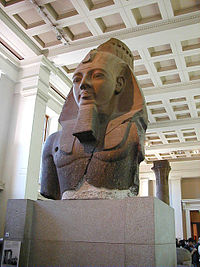Younger Memnon
This article includes a improve this article by introducing more precise citations. (December 2023) ) |
| Younger Memnon colossal figure | |
|---|---|
 The Younger Memnon (Ramesses II) | |
| Material | Granite |
| Size | H: 267 cm (105 in) W: 203 cm (80 in) |
| Created | c. 1270 BC |
| Period/culture | 19th Dynasty |
| Place | Ramesseum, Doorway |
| Present location | Room 4, British Museum, London |
| Identification | EA 19 |
The Younger Memnon is an
Description
The Younger Memnon is 2.7 metres (8 ft 10 in) high × 2 metres (6 ft 7 in) wide (across the shoulders). It weighs 7.25 tons and was cut from a single block of two-coloured granite. There is a slight variation of normal conventions in that the eyes look down slightly more than usual, and to exploit the different colours (broadly speaking, the head is in one colour, and the body another).
Acquisition
Belzoni



Following an idea mentioned to him by his friend
Anticipated by Shelley's poem "
British Museum

It was later acquired from Salt in 1821 by the British Museum and was at first displayed in the old

In February 2010, the statue was featured as object 20 in A History of the World in 100 Objects, a BBC Radio 4 programme by British Museum director Neil MacGregor.[2][3]
References
- ^ "The Younger Memnon › The British Museum". Britishmuseum.org. Retrieved 16 November 2015.
- ^ "A History of the World – Object: Statue of Ramesses II". BBC. Retrieved 6 June 2010.
- ^ "Colossal bust of Ramesses II, the 'Younger Memnon' › The British Museum". Britishmuseum.org. 14 May 2010. Retrieved 6 June 2010.
Sources
- 3D model of the Younger Memnon via photogrammetric survey
- Encyclopaedic.net – extracts from Belzoni's account
- Publications
- James, T. G. H.; Davies, W. V. (1983), Egyptian Sculpture, Harvard University Press, p. 41, ISBN 978-0-674-24161-9
- G. Belzoni, Narrative of the operations and recent discoveries within the pyramids, temples, tombs, and excavations in Egypt and Nubia I (London, John Murray, 1822), pp. 61–80
- S. Quirke and A.J. Spencer, The British Museum book of ancient Egypt (London, The British Museum Press, 1992), pp. 126–7
- Albert M. Lythgoe, 'Statues of the Goddess Sekhmet', The Metropolitan Museum of Art Bulletin Vol. 14, No. 10, Part 2 (Oct., 1919), pp. 1+3-23
- ISBN 0-226-54209-2
